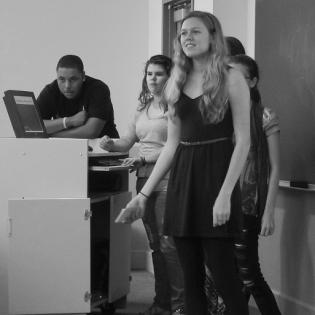Take Action!
Students conduct and evaluate their service project, then celebrate their success. After the service project, invite guests, volunteers, community members, and other students to celebrate with the class.
Learners will:
- carry out the planned service project(s).
- evaluate the community response.
- reflect on the goals and outcomes of the service project experience.
- demonstrate the impact of their service project by summarizing data.
- celebrate their hard work and efforts to make the community healthier.
How has Building Healthy Communities helped you to become healthier? What are you doing more of? Less of? How do you feel?
Instructions
Discuss the pre-service reflection questions:
- Why is this event important to you?
- What are our goals for the day?
- How will we know that today was a success?
Guide students as they carry out their planned service project to promote a healthy community. Be available to facilitate without giving directions or solving problems for the students. Set the parameters for time and place, help them brainstorm solutions to issues that arise, and give moral support, as needed.
At the end of the day, service project activity, or presentations, distribute Handout: Community Response Forms to willing participants.
Have students sit in a circle and discuss their answers to these questions:
- Through this service project, what did you learn about yourself?
- What did you learn about working with others?
- What did you learn about your community and your relationship to the community?
- What went well?
- What didn’t go as well?
- How did the project contribute to improving the community’s health?
- How will you use what you learned through this experience?
- What surprised you most about yourself, others, or the community?
Help students plan a demonstration project in which students share their work and the results of the service project with other students or community members.
Students thank those who helped to make the project happen and send thank you letters to anyone who donated time, money, or supplies including local organizations, businesses, parents, teachers, and principals.
Students reflect on their own growth over the course of this unit by comparing journal entries. What changes do they see in eating or exercise or TV time habits over the course of Building Healthy Communities? Are they eating more fruits and vegetables and less junk food (extras)? Are they more aware of what they eat and how much?
Through analysis of surveys, research, interests, and talents, students select and plan a service project to improve an area of community health. They carry out the project and demonstrate the process and outcomes to a community audience.
Philanthropy Framework
-
Strand PHIL.IV Volunteering and Service
-
Standard VS 03. Providing Service
-
Benchmark HS.1 Provide a needed service.
-
Benchmark HS.3 Describe the task and the student role.
-
Benchmark HS.5 Articulate and demonstrate the safety procedures that are part of the volunteer experience.
-
-
Standard VS 04. Raising Private Resources
-
Benchmark HS.1 Build a case for giving, explaining why resources (volunteers and money) are needed.
-
-
Standard VS 05. Integrating the Service Experience into Learning
-
Benchmark HS.2 Evaluate progress on the service-learning project before, during, and after the project.
-
Benchmark HS.3 Identify outcomes from the service.
-
-
